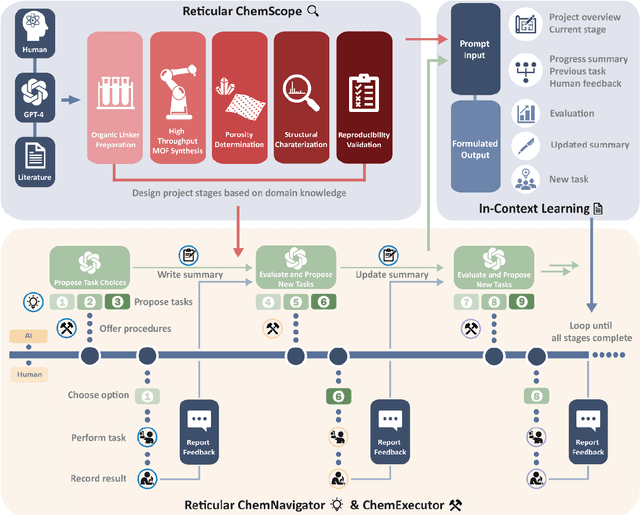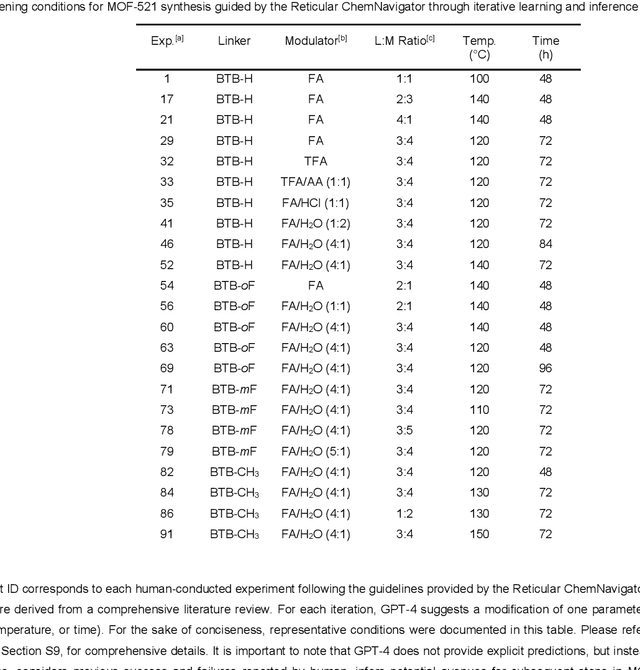Nakul Rampal
Single and Multi-Hop Question-Answering Datasets for Reticular Chemistry with GPT-4-Turbo
May 03, 2024Abstract:The rapid advancement in artificial intelligence and natural language processing has led to the development of large-scale datasets aimed at benchmarking the performance of machine learning models. Herein, we introduce 'RetChemQA,' a comprehensive benchmark dataset designed to evaluate the capabilities of such models in the domain of reticular chemistry. This dataset includes both single-hop and multi-hop question-answer pairs, encompassing approximately 45,000 Q&As for each type. The questions have been extracted from an extensive corpus of literature containing about 2,530 research papers from publishers including NAS, ACS, RSC, Elsevier, and Nature Publishing Group, among others. The dataset has been generated using OpenAI's GPT-4 Turbo, a cutting-edge model known for its exceptional language understanding and generation capabilities. In addition to the Q&A dataset, we also release a dataset of synthesis conditions extracted from the corpus of literature used in this study. The aim of RetChemQA is to provide a robust platform for the development and evaluation of advanced machine learning algorithms, particularly for the reticular chemistry community. The dataset is structured to reflect the complexities and nuances of real-world scientific discourse, thereby enabling nuanced performance assessments across a variety of tasks. The dataset is available at the following link: https://github.com/nakulrampal/RetChemQA
A Multi-Grained Symmetric Differential Equation Model for Learning Protein-Ligand Binding Dynamics
Feb 01, 2024Abstract:In drug discovery, molecular dynamics (MD) simulation for protein-ligand binding provides a powerful tool for predicting binding affinities, estimating transport properties, and exploring pocket sites. There has been a long history of improving the efficiency of MD simulations through better numerical methods and, more recently, by utilizing machine learning (ML) methods. Yet, challenges remain, such as accurate modeling of extended-timescale simulations. To address this issue, we propose NeuralMD, the first ML surrogate that can facilitate numerical MD and provide accurate simulations in protein-ligand binding. We propose a principled approach that incorporates a novel physics-informed multi-grained group symmetric framework. Specifically, we propose (1) a BindingNet model that satisfies group symmetry using vector frames and captures the multi-level protein-ligand interactions, and (2) an augmented neural differential equation solver that learns the trajectory under Newtonian mechanics. For the experiment, we design ten single-trajectory and three multi-trajectory binding simulation tasks. We show the efficiency and effectiveness of NeuralMD, with a 2000$\times$ speedup over standard numerical MD simulation and outperforming all other ML approaches by up to 80% under the stability metric. We further qualitatively show that NeuralMD reaches more stable binding predictions compared to other machine learning methods.
Image and Data Mining in Reticular Chemistry Using GPT-4V
Dec 09, 2023Abstract:The integration of artificial intelligence into scientific research has reached a new pinnacle with GPT-4V, a large language model featuring enhanced vision capabilities, accessible through ChatGPT or an API. This study demonstrates the remarkable ability of GPT-4V to navigate and obtain complex data for metal-organic frameworks, especially from graphical sources. Our approach involved an automated process of converting 346 scholarly articles into 6240 images, which represents a benchmark dataset in this task, followed by deploying GPT-4V to categorize and analyze these images using natural language prompts. This methodology enabled GPT-4V to accurately identify and interpret key plots integral to MOF characterization, such as nitrogen isotherms, PXRD patterns, and TGA curves, among others, with accuracy and recall above 93%. The model's proficiency in extracting critical information from these plots not only underscores its capability in data mining but also highlights its potential in aiding the creation of comprehensive digital databases for reticular chemistry. In addition, the extracted nitrogen isotherm data from the selected literature allowed for a comparison between theoretical and experimental porosity values for over 200 compounds, highlighting certain discrepancies and underscoring the importance of integrating computational and experimental data. This work highlights the potential of AI in accelerating scientific discovery and innovation, bridging the gap between computational tools and experimental research, and paving the way for more efficient, inclusive, and comprehensive scientific inquiry.
GPT-4 Reticular Chemist for MOF Discovery
Jun 20, 2023



Abstract:We present a new framework integrating the AI model GPT-4 into the iterative process of reticular chemistry experimentation, leveraging a cooperative workflow of interaction between AI and a human apprentice. This GPT-4 Reticular Chemist is an integrated system composed of three phases. Each of these utilizes GPT-4 in various capacities, wherein GPT-4 provides detailed instructions for chemical experimentation and the apprentice provides feedback on the experimental outcomes, including both success and failures, for the in-text learning of AI in the next iteration. This iterative human-AI interaction enabled GPT-4 to learn from the outcomes, much like an experienced chemist, by a prompt-learning strategy. Importantly, the system is based on natural language for both development and operation, eliminating the need for coding skills, and thus, make it accessible to all chemists. Our GPT-4 Reticular Chemist demonstrated the discovery of an isoreticular series of metal-organic frameworks (MOFs), each of which was made using distinct synthesis strategies and optimal conditions. This workflow presents a potential for broader applications in scientific research by harnessing the capability of large language models like GPT-4 to enhance the feasibility and efficiency of research activities.
 Add to Chrome
Add to Chrome Add to Firefox
Add to Firefox Add to Edge
Add to Edge